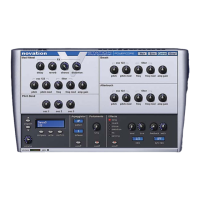Elements of a Sound
Tone
Musical sounds consist of several different related pitches occurring simultaneously. The
loudest is referred to as the ‘Fundamental’ pitch and corresponds to the perceived note of the
sound. Pitches related to the fundamental are called harmonics (sometimes also referred to as
‘overtones’) and these are multiples of the fundamental (i.e. x2, x3, x4, x5, x6..... etc.). The
number of harmonics and their relative loudness to the fundamental determines the tone or
‘Timbre’ of the sound. Some waveforms contain both even and odd numbered harmonics (i.e.
fundamental plus x2, x3, x4, x5... etc.), others contain only odd numbered harmonics
(fundamental and x3, x5, x6, x7.... etc.). Some contain lots of harmonics (even and/or odd)
whilst others only have a few.
Consider two instruments such as a clarinet and a trumpet playing exactly the same note at
exactly the same volume. Even though the pitch and volume are identical, they sound
completely different. This is because the trumpet is rich in even and odd harmonics whereas
the clarinet only contains odd numbered harmonics. Consider also a flute - another very
different tone. This is because a flute typically has very few harmonics. When a sound has a lot
of harmonics, the sound will be bright; when a sound has very few harmonics, it will be mellow
in tone.
However, tone is rarely static on most instruments and varies during the course of the note.
Generally, sounds start off quite bright and, because higher harmonics have less energy, they
tend to die away first followed by lower frequency harmonics - the result is that the sound
gradually gets softer in tone throughout the note. Other instruments start off with few
harmonics but higher harmonics build up throughout the course of a note so that the sound
gets gradually brighter. Tonal changes are often linked with level changes - i.e. the harder you
hit, pluck, scrape or blow something, not only is it louder but it is usually brighter in tone.
Volume
Volume, which is referred to as the amplitude or loudness of the sound, is determined by how
large the vibrations are. Think of a guitar string - pluck it softly so that it hardly vibrates and the
sound will be low in level. Pluck it hard, however, so that it moves a lot and the sound will be
louder.
In the diagram above, the waveform on the right is quieter than the one on the left.
However, volume is not a static element of a sound as it tends to change throughout a note’s
duration. Consider the sound of a piano and, say, an oboe - the piano is initially very loud but
dies away over time. The oboe, on the other hand, has a soft start but sustains during the
course of the note (though not always). Other instruments’ amplitude varies in different ways as
well - some sounds start slowly (bowed instruments, for example) whilst other sounds ring on
for a long time after the note has sounded (a gong, for example). The way in which a sound
varies over time is known as the ‘envelope’ .
9 Synthesis Tutorial

